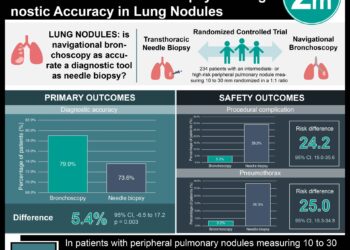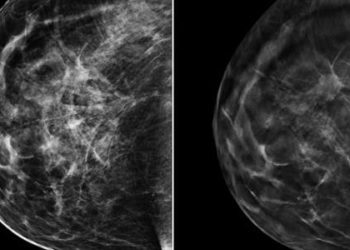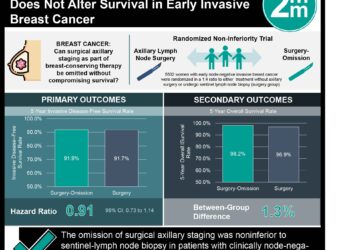Combination mammography and breast tomosynthesis improves breast cancer screening [Classics Series]
This study summary is an excerpt from the book 2 Minute Medicine’s The Classics in Medicine: Summaries of the Landmark Trials
1. The addition of breast tomosynthesis to digital mammography in breast cancer screening improved lesion conspicuity, thereby significantly increasing the rate of cancer detection and the overall positive predictive value of screening.
2. The rate of patient recall for further workup of a positive screen was significantly reduced with the addition of tomosynthesis.
Original Date of Publication: June 2014
Study Rundown: Breast cancer screening entails yearly mammography and clinical breast exam for women aged 50-70 years, among whom it has been shown to reduce mortality. However, mammography alone suffers from a limited positive predictive value, with an excess of false-positive results believed to be due to overlapping breast tissue. Breast tomosynthesis (BT) was developed to offset this limitation. By acquiring multiple low-dose images of the breast at focal planes of varying depth and reconstructing a single image or depth stacked series of images, BT reduces the “noise” of overlapping densities within the breast to more easily highlight true abnormalities. As imaging technology has progressed with large-field, fast-reading detectors, BT has now become feasible in routine practice, and the referenced study sought to examine how large-scale combination of mammography and BT compares to mammography alone in improving upon the specificity of breast cancer screening. In a retrospective review of nearly a half million screening examinations performed before and after the introduction of combined mammography and BT in routine practice, the combination technique significantly increased the positive predictive value of a positive screening examination from 4.3% to 6.4%, and of a subsequent biopsy from 24.2% to 29.2%. This improvement was reflected in an increase in the cancer detection rate at screening from 4.2 by mammography alone to 5.4 per 1000 examinations by the combined method. Additionally, the combination of mammography and BT reduced the overall recall rate, or the proportion of patients in whom a positive screen necessitated further workup, from 107 to 91 per 1000 examinations. Together, these findings suggested that the addition of BT to routine breast cancer screening may improve screening specificity, thereby reducing unnecessary interventions due to false-positive results. However, a direct determination of sensitivity and specificity could not be calculated as the dataset did not include patient-level information on the occurrence of interval cancers. The study was additionally limited by its retrospective nature and inherent lack of randomization, introducing the potential for selection bias and differences in baseline patient characteristics to influence the results obtained.
Click to read the study in JAMA
In-Depth [retrospective cohort]: This retrospective trial was conducted at 13 separate sites over two separate periods, one prior to the introduction of BT at each institution (one year in duration), and the other following the start of standard screening with combined digital mammography and BT (average duration of 17 months). Notably, only two sites were able to replace all equipment with tomography capable devices at once, while others maintained a hybrid environment in which mammography alone was still used after the transition. A total of 454 850 screening examinations were included in the primary analysis, read by 139 radiologists across all sites, with 61.8% performed during the first period (mammography alone), and 38.2% performed during the second period (mammography + BT). Comparing those studies performed prior to the introduction of BT to mammographic screening, a specific set of metrics was tabulated to compare the efficacy of mammography with and without BT: The patient recall rate, or proportion of patients in whom a positive screen necessitated additional imaging; the cancer detection rate, or proportion of patients in whom a positive screen detected a true cancer, and the positive predictive value for both patient recall and for biopsies performed as a result of a screening examination. For mammography alone, the rate of patient recall was 107 per 1000 screens as compared to 91 per 1000 screens for mammography + BT, resulting in a decrease in the recall rate of -16 (95%CI -18 to -14; p <0.001) per 1000 screens. The difference in biopsy rate between mammography without and with BT was +1.3 (95%CI 0.4-2.1; p = 0.004) per 1000 screens. The overall cancer detection rate (n=815 invasive cancers, n=392 ductal carcinoma in situ) for mammography alone was 4.2 per 1000 screens, while it increased to 5.4 per 1000 screens with the addition of tomography, resulting in an increase of 1.2 (95%CI 0.8-1.6; p <0.001) per 1000 screens. When considering invasive cancers alone, the net increase in cancer detection rate was unchanged. The PPV for recall for mammography alone was 4.3% versus 6.4% with the addition of BT, for an overall increase of 2.1% (95%CI 1.7-2.5% p <0.001), while for biopsy, the net increase in PPV was 5.0% (95%CI 3.0-7.0%; p <0.001). A secondary analysis was performed using examinations the second period alone, comparing mammograms performed without BT to those performed with BT in an effort to address the potential for selection bias to affect the results given the hybrid nature of the transition at many sites. A statistically significant improvement in cancer detection with mammography + BT was found (p <0.001), consistent with those findings from the primary analysis.
Friedewald SM, Rafferty EA, Rose SL, Durand MA, Plecha DM, Greenberg JS, et al. Breast Cancer Screening Using Tomosynthesis in Combination With Digital Mammography. The Journal of The American Medical Association. 2014 Jun 25;311(24):2499–2507.
©2022 2 Minute Medicine, Inc. All rights reserved. No works may be reproduced without expressed written consent from 2 Minute Medicine, Inc. Inquire about licensing here. No article should be construed as medical advice and is not intended as such by the authors or by 2 Minute Medicine, Inc.







![The ABCD2 score: Risk of stroke after Transient Ischemic Attack (TIA) [Classics Series]](https://www.2minutemedicine.com/wp-content/uploads/2013/05/web-cover-classics-with-logo-medicine-BW-small-jpg-75x75.jpg)